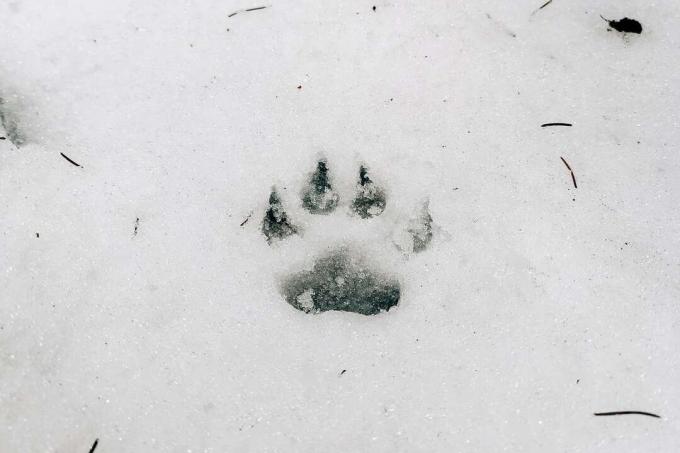
Who sneaks through the snowy garden? Maybe a fox (Vulpes vulpes)? This is revealed by the paw prints, which allow a fox to be identified by typical track marks, as described below.
In a nutshell
- Risk of confusion with other animal tracks
- Fox tracks in city gardens are just as possible as in the country
- Walking and running tracks different
Table of contents
- recognize fox tracks
- Track characteristics depending on gait
- Fox tracks, risk of confusion
- frequently asked Questions
recognize fox tracks
Snow-covered gardens make it easy to spot visiting animal guests, as the paws are usually clearly visible in the falling snow. Fox tracks can therefore be identified quickly if they have the following main characteristics:
- Size and shape: about four centimeters wide, five centimeters long and slightly elongated
- Pad count: four toe pads with claws; a rounded main pad in the rear impression area
- Bale distance: relatively large (cross markings possible through gaps without ball contact)
- Claws: one claw on each ball of the toes; outer claws slightly curved inwards; Middle claws close together
- Toes: inner toes strongly forward
- Hind footsteps: hind paw tracks slightly offset from front tracks; same size

A notice: These features of fox tracks relate purely to walking and slow trotting.
Track characteristics depending on gait
A fox's paw prints may change in appearance as the gait increases, as described below:
- faster trot: hind paws step successively crossed into opposite front paw prints; Impression distances about 30 centimeters
- Race: different track patterns with different step lengths; but usually significantly longer distances between the footprints than when trotting or walking; Depending on the snow depth, deeper imprints

Tip: Foxes usually run when they are fleeing or chasing. This is usually preceded by a slower gait, which means that the tracks in the snow can be better assigned to the fox and the racing tracks should therefore be followed up until then.
Fox tracks, risk of confusion
Very similar to the fox track is the paw print in the snow of a smaller dog. Due to some equality characteristics, there is often a confusion between the two animal species. If you look closely and know the following differences between the footprints of dogs and foxes in the snow, you can reliably identify them:
- Paw size: fox up to a maximum of 5 x 4 centimeters - dog up to a maximum of 8 x 7 centimeters (length x width)
- Main pads: fox rounded - dog usually heart-shaped
- Ball distance: Fox's main ball further back, therefore more distance to toe balls than in dogs
- Track shape: fox narrow, elongated to oval - wider overall in dogs
- Stride length: foxes between 25 and a maximum of 80 centimeters - dogs between seven and 120 centimeters
- Distance front and hind legs: fox about 30 centimeters; in the dog, depending on body size/length, significantly smaller or larger
- Front and hind tracks: fox staggered into front tracks - in the dog almost on the same line or slightly inside; running hind tracks in the middle between front tracks and usually do not appear in front tracks as in the fox

A notice: On the surface, a cat's paw prints in the snow can also resemble those of a fox. However, cat tracks are easily distinguished from fox tracks by their smaller size, rounded shape and lack of claw marks.
frequently asked Questions
The fox does not hibernate or hibernate, so it can theoretically roam gardens at any time. Above all, hunger drives him there, which also doesn't let him stop at more populated areas, for example in cities. This is also the reason why the fox, which is otherwise active at dusk and at night, also comes out of its hiding place more frequently during the day. Foxes are particularly active during the mating season in January and February.
There are no restrictions on this, because foxes have thick winter fur and a surprisingly good heat exchange system. Although the winter fur on the legs and paws is thinner and the latter are "naked", the closeness takes care of it of arteries and veins for rapid warming of the returning cold blood from the paws. In this way, a constant body temperature can be maintained and the paws protected from frostbite by the flow of warm blood.
Foxes usually go to gardens to forage. As a rule, they are then alone and other foxes avoid each other's territory, so you will only find the tracks of one fox. An exception is the mating season, when males and females can meet in your garden. However, if the fox/the pair of foxes moves away, other foxes can of course follow and run through the snow in your garden.

